
Clarkia franciscana is a rare species of flowering plant in the evening primrose family known by the common name Presidio clarkia. It is endemic to the San Francisco Bay Area of California, where it is known only from two populations at the Presidio of San Francisco and three occurrences in Oakland. The plant is known only from serpentine soils.

Lewisia brachycalyx is a species of flowering plant in the family Montiaceae, known by the common name short-sepal bitter-root or shortsepal lewisia. It is native to the mountains of the southwestern United States and Baja California, where it grows in moist habitat such as meadows. It is a deciduous perennial growing from a short thick taproot and caudex unit. It produces a basal rosette of thick, fleshy, blunt-tipped narrow leaves up to 8 centimeters long. The inflorescence is under 4 centimeters tall, taking the form of a cluster of several flowers sitting atop the leaf rosette. Each flower has 5 to 9 shiny white or pink petals about 2 centimeters long. At the center are many stamens and stigmas clumped together. The Latin specific epithet brachycalyx means “having a short calyx”.

Lewisia cantelovii is an uncommon species of flowering plant in the family Montiaceae known by the common name Cantelow's lewisia. It is endemic to California, where it is known from the northeastern mountain ranges from the Klamath Mountains to the northern Sierra Nevada. It grows in rocky, moist mountain habitat. This is a perennial herb growing from a short, thick taproot and caudex unit. It produces a basal rosette of thick, fleshy, blunt-tipped spoon-shaped leaves with serrated edges. The inflorescence is a very slender erect stem up to 45 centimeters tall topped with a spreading panicle of flowers and glandular, toothed bracts. Each flower has 5 to 7 oval petals each one half to one centimeter long. The petals are white or very pale pink with sharp dark pink veins. At the center of the flower are five stamens tipped with dark pink anthers.

Lewisia columbiana, the Columbian lewisia, is a species of flowering plant in the family Montiaceae. It is native to the western United States and British Columbia, where it grows in rocky mountain habitats. This herbaceous perennial grows from a short, thick taproot and caudex unit. It produces a basal rosette of many thick, fleshy, tapering, blunt-tipped or pointed leaves with smooth edges, each 2 to 10 centimeters long. The inflorescence arises on several stems up to about 30 centimeters tall, each stem bearing an array of up to 100 flowers each. Near the flowers are small, pointed bracts tipped with shiny spherical resin glands. The flower has 4 to 11 petals, each up to about a centimeter in length and oval in shape with a notched tip. The petals are white to pale pink, usually with sharp dark pink veining.

Lewisia cotyledon is a species of flowering plant in the family Montiaceae known by the common names Siskiyou lewisia and cliff maids. It is native to southern Oregon and northern California, where it grows in rocky subalpine mountain habitat.

Lewisia disepala is a species of flowering plant in the family Montiaceae known by the common name Yosemite lewisia.

Lewisia leeana is a species of flowering plant in the family Montiaceae known by the common name quill-leaf lewisia. It is native to California and Oregon, where it grows in the mountains of the Sierra Nevada and Klamath Ranges. This is a perennial herb growing from narrow, woody taproot connected to one or more caudices. It produces a basal rosette of many fleshy flat to cylindrical blunt-tipped leaves up to 4 centimeters long. The inflorescence bears many flowers on erect, branching stems up to about 24 centimeters tall. Each flower has 5 to 8 white, pink, or purplish petals each about half a centimeter long.
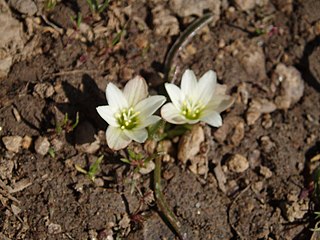
Lewisia nevadensis is a species of flowering plant in the family Montiaceae known by the common name Nevada lewisia. It is native to much of the western United States, where it grows in moist mountain habitat, such as meadows. This is a small perennial herb growing from a taproot and caudex unit. It produces a basal rosette of several narrow, fingerlike to threadlike fleshy leaves up to 13 centimeters long. The inflorescence is a bundle of short stems a few centimeters tall each bearing a flower. The flower has 5 to 10 shiny white to pale pink petals each 1 to 2 centimeters long, pointed or with blunt tips. At the center are many stamens. This is sometimes grown as an ornamental plant suitable for alpine and rock gardens.

Lewisia oppositifolia is a rare species of flowering plant in the family Montiaceae known by the common name opposite-leaf lewisia. It is native to the Klamath Mountains of Josephine County, Oregon, and Del Norte County, California, where it is a local serpentine endemic generally found in moist areas. This is a perennial herb growing from a small taproot and caudex unit. It produces a basal rosette of several lance-shaped, blunt-tipped fleshy leaves up to 11 centimeters long. There are sometimes smaller leaves located on the lower stem. The inflorescence is made up of one or more erect stems up to about 20 centimeters long, each bearing 1 to 6 flowers. The flower has 8 to 11 white to pale pink petals with blunt or jagged tips, each between 1 and 2 centimeters long. At the center are several stamens with pale anthers. This plant has a limited distribution and it is threatened by human activity in the area, such as logging.

Lewisia pygmaea is a species of flowering plant in the family Montiaceae known by the common name alpine lewisia and pygmy bitterroot. It is native to western North America from Alaska and Alberta to California and New Mexico, where it grows in many types of moist, rocky mountain habitat, such as gravel beds and sandy meadows. This is a highly variable species with a wide distribution, and it often hybridizes with other Lewisia species, making identification difficult. In general, this is a petite perennial herb growing from a taproot and caudex unit, and producing a basal rosette of several leaves 2 to 8 centimeters long. The leaves are narrow but thick and fleshy, blunt-tipped, and linear to lance-shaped. The inflorescence is usually made up of a few very short stems each bearing one or more flowers which appear to be sitting on or within the basal leaf rosette. Each flower has 5 to 9 white, pink or red petals which may or may not have dark veining or striping. The petals are 4 millimeters to 1 centimeter long.

Lewisia stebbinsii is a rare species of flowering plant in the family Montiaceae known by the common name Stebbins' lewisia. It is endemic to California, where it is known from less than fifteen sites in the Inner North Coast Ranges of Mendocino and Trinity Counties, mainly in Mendocino National Forest.
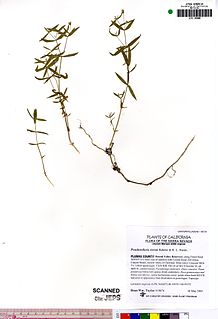
Pseudostellaria sierrae is a species of flowering plant in the family Caryophyllaceae known by the common name Sierra starwort.
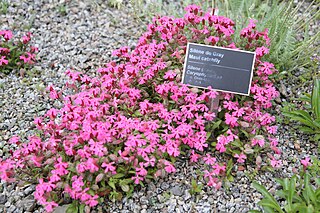
Silene grayi is a species of flowering plant in the family Caryophyllaceae known by the common name Gray's catchfly. It is native to the mountains of Oregon and northern California, including the Klamath Mountains, where it grows in chaparral, mountain forests, and the talus of high slopes in alpine climates. It has been observed to occur in a plant association with oceanspray, littleleaf silverback, and Gray's bedstraw. It is a perennial herb producing a decumbent or erect stem up to 20 or 30 centimeters long from a woody, branching caudex. The base of the plant is covered in tufts of leaves. These basal leaves are lance-shaped to nearly spoon-shaped, fleshy, and up to 4 centimeters long. Smaller, narrower leaves occur farther up the stems. Each flower has a tubular calyx of fused sepals lined with ten green or red veins and covered in glandular hairs. It is open at the tip, revealing five pink or purple petals. The petal tips and appendages are divided into narrow lobes.
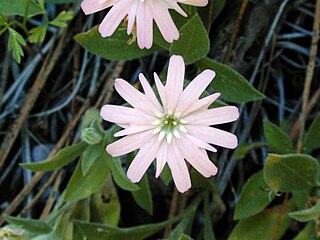
Silene hookeri is a species of flowering plant in the family Caryophyllaceae known by the common names Hooker's silene, Hooker's catchfly, Hooker's Indian pink, and Hooker's glandular campion.
Silene marmorensis is a rare species of flowering plant in the family Caryophyllaceae known by the common names Marble Mountain catchfly, Marble Mountain campion, and Somes Bar campion. It is endemic to the southern Klamath Mountains of northern California, where it grows in mountain woodlands and forests. It is a perennial herb producing several stems and shoots from a woody, branching caudex and thick taproot. The hairy, glandular stems grow erect to a maximum height near 40 centimeters. The lance-shaped leaves are a few centimeters long and are borne in pairs, the lowermost drying early. The inflorescence is a terminal cyme of flowers at the top of the stem, and some flowers may occur in the leaf axils. Each flower has a hairy, veined calyx of fused sepals. The flowers bloom at night, the five pinkish or green-tinged petals opening at the tip of the calyx.
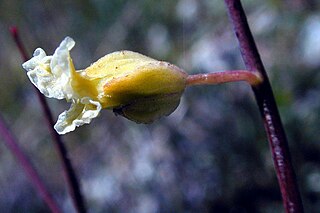
Streptanthus glandulosus is a species of flowering plant in the mustard family known by the common name bristly jewelflower. It is native to California and southwestern Oregon, where it grows in many types of habitat, including grassland, chaparral, and woodlands. Genetic and other analyses indicate that it is a species complex with ten subspecies which evolved as populations were isolated from each other. The complex includes subspecies previously considered separate species, such as the rare Tiburon jewelflower endemic to the San Francisco Bay Area. Plants in the complex are variable. In general they are annual herbs growing 10 centimeters to over a meter in height. They may be hairless to hairy to bristly. The ephemeral basal leaves have blades borne on winged petioles. Leaves higher on the stem are linear to lance-shaped and clasp the stem at their bases. Flowers occur at intervals along the upper stem. Each flower has an urn-shaped calyx of sepals one half to over one centimeter long which can be most any color from white to yellowish to pink or purple to nearly black. Purple, white, or purple-veined white petals emerge from the tip. The fruit is a straight or curving silique up to 11 centimeters long.

Streptanthus vernalis is a rare species of flowering plant in the mustard family known by the common name early jewelflower. It was first observed in the 1970s but not actually described to science until 2005. It is endemic to Lake County, California, where it is known from a single occurrence at Three Peaks near the Napa County line. It is apparently limited to serpentine outcrops in forested and chaparral habitat. Genetic analysis indicates that the species is distinct from other Streptanthus and is most closely related to Streptanthus morrisonii, which it resembles. It is a hairless annual herb producing an erect branching or unbranched stem 2 to 20 centimeters tall. The ephemeral basal leaves have thick, fleshy leaves which are green and unmottled on top and purple on the undersides. Leaves higher on the stem are linear to lance-shaped and lack petioles. Flowers occur at intervals along the upper stem. Each flower has an urn-shaped calyx of sepals which is solid green with no purple or yellowish tinge. The petals emerging from the tip are white without darker veining. The fruit is a flattened straight silique 3 to 5 centimeters long containing orange seeds.

Calochortus syntrophus is a rare species of flowering plant in the lily family known by the common names Callahan's mariposa lily and clustered mariposa lily. It is endemic to northern California, where it occurs in a remote area north of Montgomery Creek in Shasta County. It has also been spotted in adjacent Tehama County. Its habitat includes open, rocky areas with moist or wet soils in oak woodland territory. It was first discovered in 1993 and its description was published the following year.

Silene polypetala is a rare species of flowering plant in the family Caryophyllaceae known by the common names eastern fringed catchfly and fringed campion. It is native to Georgia and northern Florida in the United States. It is threatened by the loss and degradation of suitable habitat. It is a federally listed endangered species of the United States.
Lewisia maguirei is a rare species of flowering plant in the family Montiaceae known by the common name Maguire's lewisia, or Maguire's bitterroot. It is endemic to Nevada in the United States, where it is known only from eastern Nye County.



















